In this digital age, learning to code is not just a valuable skill for children; it's an opportunity to shape a promising future. However, learning to code for kids: Should they learn online or offline? So, is offline learning the right choice, or should kids opt for online lessons? Does online learning affect their concentration?
Learning to code for kids is a process that introduces them to computer programming. It helps children develop the skills needed to write code to control computers or create tech projects.
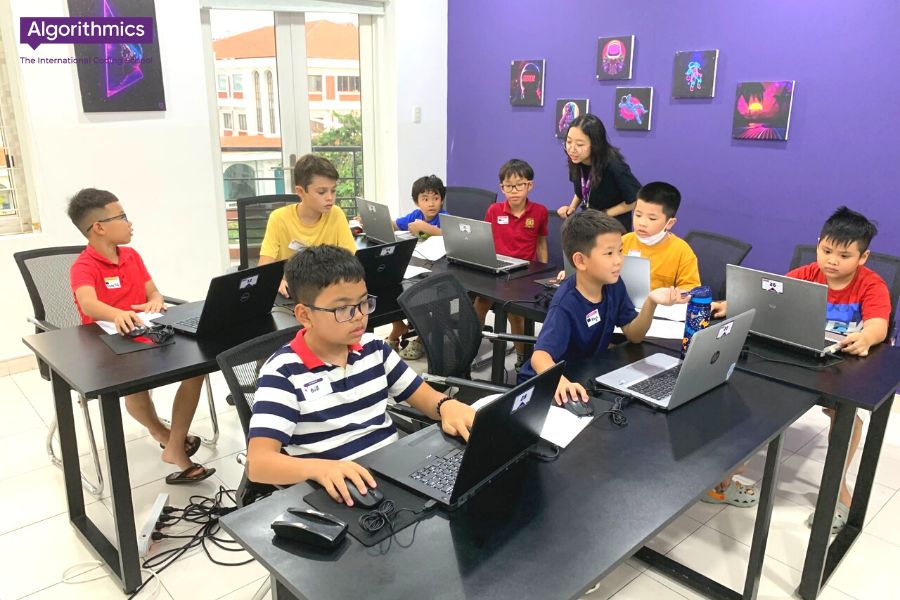
Coding curricula for kids are typically designed to be understandable and engaging. In these courses, children are encouraged to be creative, solve problems, and develop logical thinking through coding tasks and small tech projects. This not only enhances their programming skills but also improves their logical thinking, problem-solving abilities, and teamwork.
Learning to code for kids can take various forms, including in-person classes at schools, online courses, and educational apps and games. It's not just about understanding technology; it also opens doors to their future in an increasingly digital world.
Offline, in-person coding classes represent a traditional way of learning. In these classes, students attend programming courses at physical locations, often in specific classrooms. During these lessons, experienced teachers guide children in executing their own projects.

Guidance from Experienced Teachers: In offline coding classes, there are typically experienced teachers who can provide individual guidance and immediate help when students encounter challenges.
Communication and Collaboration: Offline coding lessons help children build essential skills such as communication, teamwork, and collaboration. Interacting with peers and making new friends can enhance their learning experience.
Structured Learning Environment: Classroom environments foster discipline and focus, helping students concentrate better on their studies.
Fixed Time and Location: Attending classes at specific times and places can be challenging for those with limited flexibility or who live far from the learning centers.
Higher Costs: Offline coding classes often come with tuition fees, which can be more expensive compared to online alternatives.
Online coding classes involve students learning programming via the internet, typically from the comfort of their homes or anywhere with an internet connection. Online learning has gained popularity, especially during and after the COVID-19 pandemic, due to its flexibility.

Convenience and Flexibility: Online learning allows students to choose when and where they want to study, making it suitable for those with busy schedules.
Interactive Learning Habits: Many online programming platforms offer interaction through forums, live chats, and even virtual classrooms with instructors.
Lower Costs: Learning online often comes with lower costs as there is no need to commute or pay for classroom infrastructure.
High Self-Motivation Required: Effective online learning requires a high degree of self-motivation. Without direct teacher supervision, students may struggle to stay focused.
Time Management: Managing one's time effectively is crucial for online learning success, which can be challenging for those lacking discipline.
Limited Direct Teacher Support: In online learning, students often lack immediate, direct support from teachers, which can be problematic when facing specific challenges.
Stable Internet Connection Required: Online learning is dependent on a stable internet connection. Interruptions in connectivity can disrupt the learning process.
Algorithmics is an international standard coding school for children in Vietnam. It offers a range of options for kids to develop their programming skills according to global standards. With Algorithmics, learning to code isn't limited to one choice. Instead, kids can choose between offline and online learning options, creating a diverse and flexible learning environment.
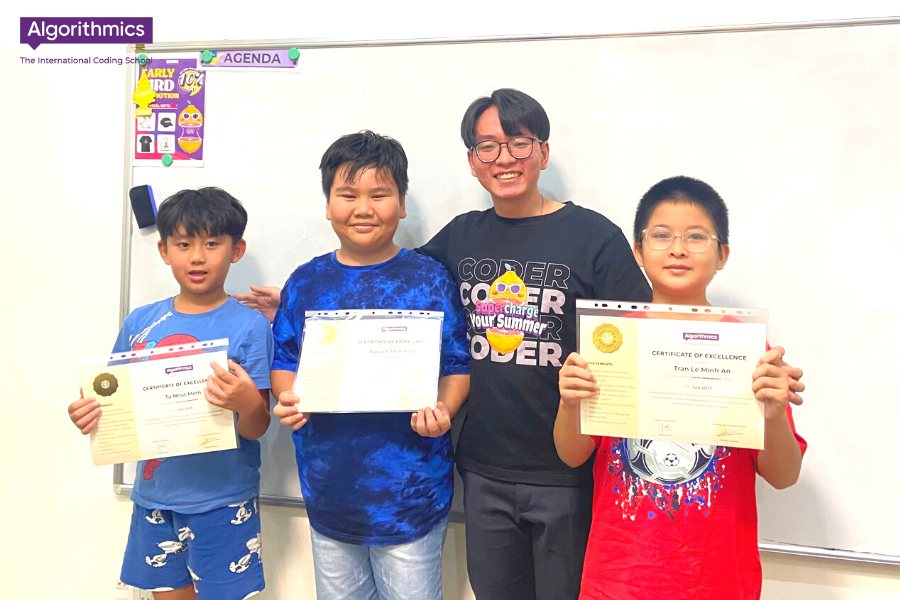
In Algorithmics' in-person classes, children enjoy a unique blend of advantages. They combine in-person learning at the center with support from experienced teachers and access to a 24/7 global learning platform. This approach ensures that kids study alongside peers from over 15 countries, offering a truly global educational experience right here in Vietnam.
If you're seeking a more flexible learning option, Algorithmics provides online coding courses. This is a fantastic option for youngsters who want to maximize their learning time and location. Regardless of the learning format, Algorithmics offers an exclusive learning platform that allows teachers to closely monitor student progress, offering assistance when needed.
Learning to code for kids is a critical consideration in this digital age. The choice between online and offline learning comes with its unique pros and cons. After reading this article, Algorithmics believes that you'll be better equipped to select the most suitable option for your child. Additionally, Algorithmics offers a trustworthy educational environment with various learning formats and an exclusive 24/7 platform for children.

Blended learning, also known as the hybrid learning approach. This is a modern learning method that combines traditional learning with online learning. It leverages the flexibility of technology and diversifies teaching methods to create a multidimensional and rich learning environment. In programming courses, Algorithmics has successfully applied the blended learning approach to provide the best learning experience for students. Let's explore blended learning and the effectiveness of this method!
Blended learning is the intelligent combination of in-person and online learning methods. This approach provides students with diverse and flexible learning experiences. Students can access knowledge through various sources, including online learning materials, video lectures, and online forums. They even have the opportunity to participate in live classes with teachers, engage in discussions, and collaborate in group work. The integration of these two learning modalities creates a multidimensional learning environment that enhances interaction and exploration. As a result, students can develop comprehensive skills and knowledge.
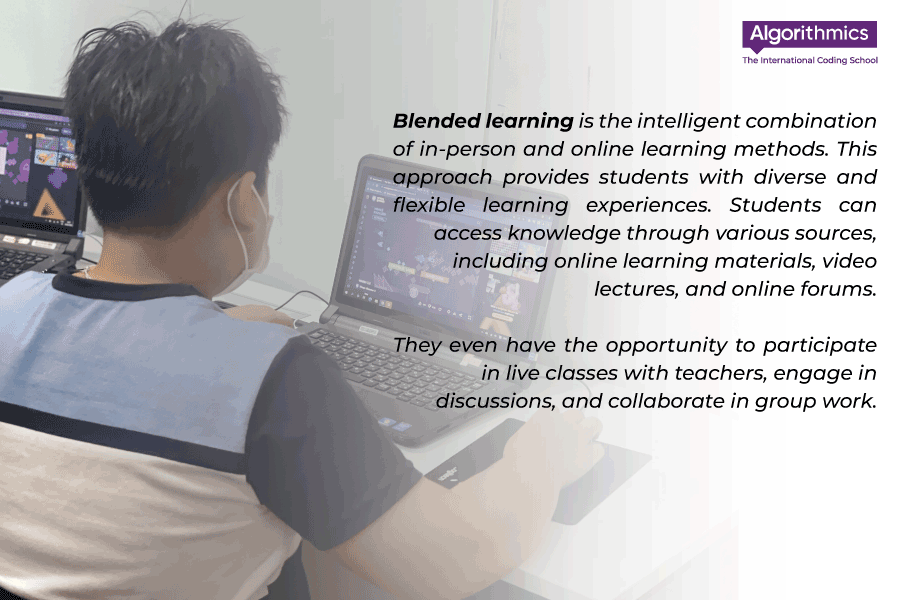
Blended learning, also known as hybrid learning, is a diverse approach to education that combines in-person and online learning methods. It offers students a variety of learning experiences and flexibility in accessing knowledge from multiple sources. Students can engage with online learning materials, video lectures, and participate in online forums and even online courses.
At the same time, students have the opportunity to participate in face-to-face classes with teachers, engage in discussions, and collaborate in group work. The combination of these two learning modalities creates a multidimensional learning environment that enhances interaction and exploration. Blended learning allows students to develop comprehensive skills and knowledge.
There are several models of blended learning commonly used in education and training:
This model allows students to alternate between in-person and online learning. It is often used in primary and secondary education. For example, students can switch between online and in-person learning environments, benefiting from the advantages of each.
The Flex model provides students with flexibility in choosing their learning methods. Teachers provide online guidance and instruction, and students manage their own time and space for online learning. Face-to-face classes are then reserved for discussions, exchanges, and resolving queries. The Flex model encourages students to develop self-directed learning skills and time management. It is commonly used in higher education settings.
In this model, students have the freedom to select online courses to supplement their traditional learning. Based on their interests and goals, students choose online courses alongside their regular studies. The Self-Blend model allows students to expand their knowledge and explore new areas flexibly. In simpler terms, it involves participating in an additional online course.
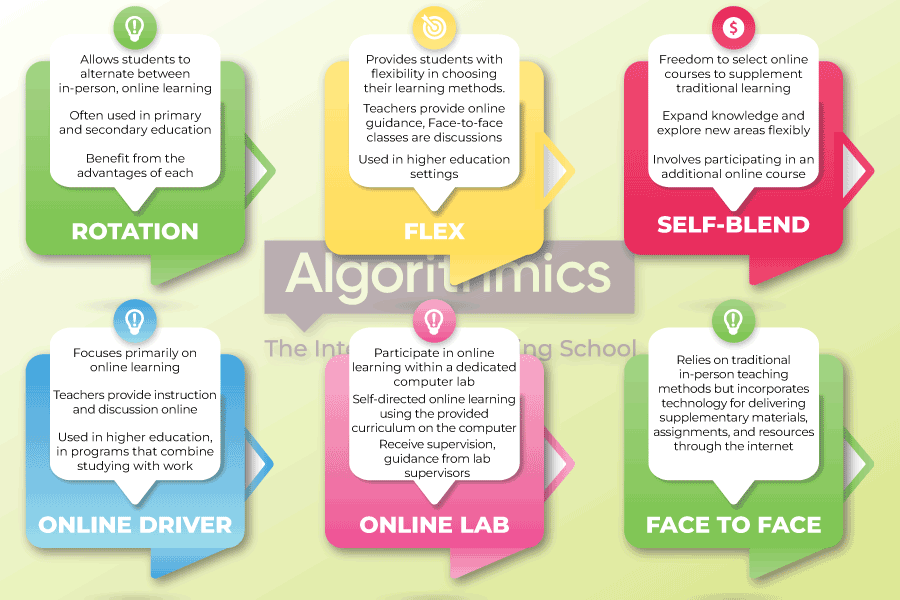
This model focuses primarily on online learning. Students rely on online tutorials, exercises, and lectures. If they have any questions or need support, teachers provide instruction and engage in discussions online. The Online Driver model offers high flexibility, allowing students to adjust their learning pace according to their individual needs. It is commonly used in higher education and in programs that combine studying with work.
This is a relatively new model where students participate in online learning within a dedicated computer lab. Students engage in self-directed online learning using the provided curriculum on the computer. However, they still receive supervision and guidance from lab supervisors.
This model primarily relies on traditional in-person teaching methods but incorporates technology for delivering supplementary materials, assignments, and resources through the internet.
Each of these blended learning models offers unique experiences and benefits, catering to different educational contexts and needs.
In general, Blended learning, as a combination of in-person and online learning, brings significant benefits to students. Firstly, the flexibility of this method allows students to take control of their time and learning space. They can adjust the learning pace according to their abilities and personal schedules. Moreover, the use of technology in the learning process enhances interaction between students and learning content. Students can access study materials anytime, complete online exercises, and receive immediate feedback from teachers.
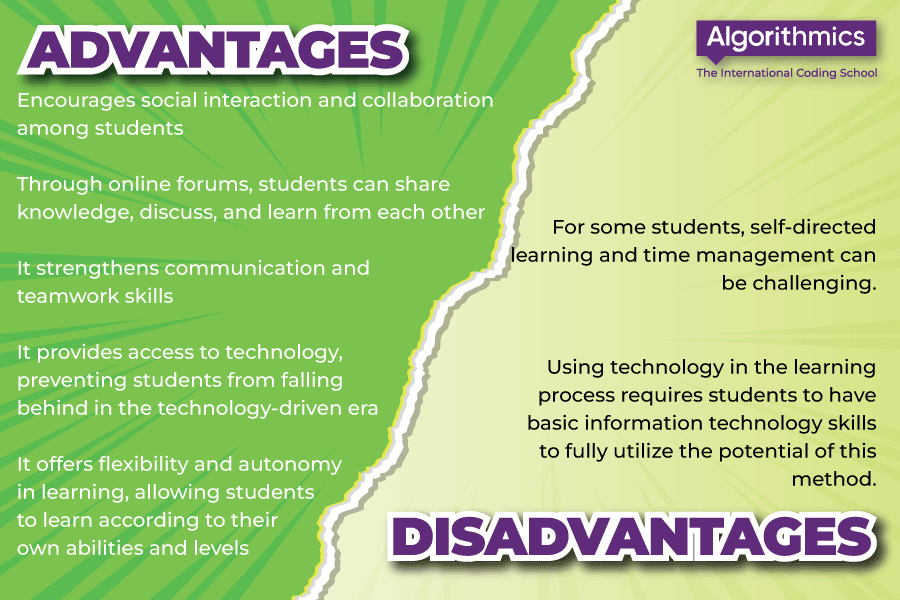
To effectively apply the blended learning method, it is crucial to choose and use appropriate technology. You need to research and apply online learning tools and platforms that align with your learning goals.
Additionally, it is important to clarify the roles of both teachers and students in the learning process. Teachers must ensure that students receive the necessary support and guidance to effectively access online learning content. Students also need to have self-awareness and time management skills to avoid falling behind in their studies.

To apply the blended learning method effectively, consider the following factors:
Start by clearly defining your learning goals. Understand what you want to achieve and identify the necessary skills and knowledge. This will help you select and leverage suitable learning materials and resources.
Determine the suitable blended learning method for your needs. You may want to combine online learning with in-person classes or engage in self-paced online learning combined with discussions and interactions with teachers and classmates. Choosing the right method will allow you to leverage the advantages of each approach and optimize the learning process.
Blended learning allows you to manage your study time independently. Create a flexible study schedule that allows you to adjust and organize your time according to your needs. Ensure you allocate enough time for both online and in-person learning and choose the appropriate timing for each method.
If you use an online learning platform, take advantage of the learning tools and interactive features it provides. Engage in discussion forums, exchange opinions with teachers and classmates, and complete online exercises and projects. If you are learning in-person, make use of group activities, discussions, and direct interactions with teachers and classmates.
Blended learning requires self-management and patience. Set your own goals, plan your activities, and consistently engage in learning activities. Additionally, be patient and don't get discouraged by difficulties and challenges in the learning process.
By considering these suggestions and adapting them to your specific learning context, you can effectively apply the blended learning method and enhance your learning outcomes.
Blended learning is applied specifically in the programming learning process at Algorithmics. Students not only have face-to-face learning with teachers but also have the opportunity to access the Algorithmics online platform 24/7 for self-study and practice. Students can access rich learning materials, complete exercises, participate in activities and projects, and receive feedback from teachers through this platform. The blended learning environment at Algorithmics creates a perfect combination of teacher support and student autonomy.
Personalizing a child's learning trajectory allows them to adjust the learning pace and actively acquire knowledge through the platform's available resources. It increases proactivity and flexibility in learning as students can access the platform anytime, anywhere.
Blended learning shortens the "distance" between teachers, students, and peers as students can simply send messages, leave questions about exercises, and teachers will quickly provide guidance and answer inquiries.
It serves as a key to access a vast repository of technology projects created by young programmers worldwide on Algo's exclusive learning platform. This becomes a reference and inspiration for students to confidently "code" their own world.
The exclusive 24/7 learning platform of Algorithmics is a special online space that provides students with flexibility and convenience in the learning process. With this platform, students can access it anytime, anywhere to study, practice, and work on projects.
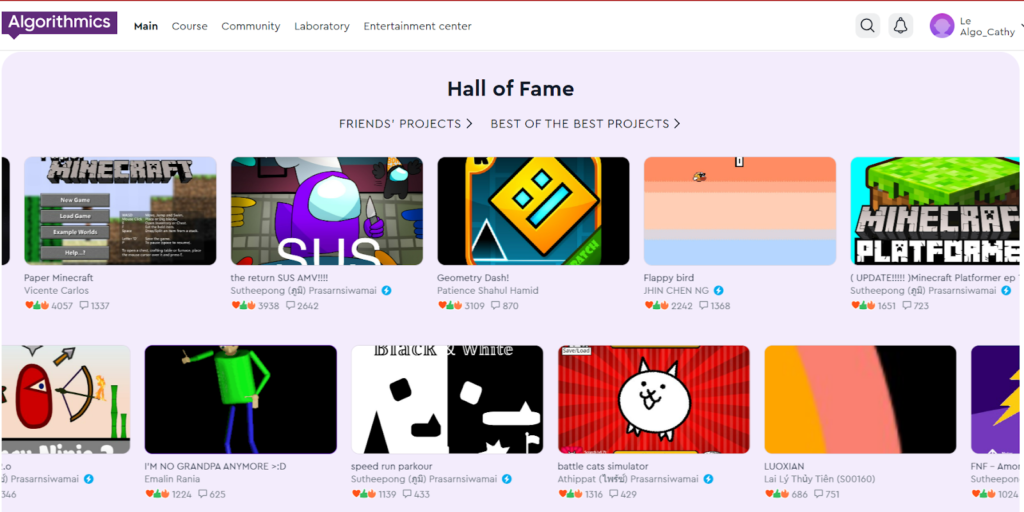
The 24/7 learning platform is not only a rich source of knowledge but also a connected environment that allows students to interact and collaborate with international peers from over 70 different countries. This is an opportunity for children to explore and learn from diverse perspectives and cultures, opening up diverse and enriching learning experiences.
On this platform, students can access a wide range of courses, lectures, study materials, and diverse and updated exercises. They can adjust their learning pace and choose courses that align with their interests and personal goals. Additionally, students can participate in activities, projects, and competitions, exploring the world of programming through practical and exciting experiences.
Blended learning is a diverse and flexible learning method that combines online and in-person learning. It brings many benefits to students, from flexibility in time and space, enhanced interaction and exploration, to autonomy and collaboration. Particularly in the field of programming, Algorithmics has successfully implemented blended learning to create the best learning environment for students. Blended learning helps students comprehensively access programming knowledge, develop skills and logical thinking, and explore the potential of technology. Explore and experience this unique combination to achieve success in programming learning.
Furthermore, parents can also register for a free assessment session for their children's abilities, technology skills, and logical thinking. This can help determine if their child is suitable for this profession at HERE
In advanced education systems (Japan, Australia…), coding is a compulsory subject right from elementary school. Parents prioritize promoting and encouraging their children to learn coding from an early age to prepare a solid luggage for the future.
Develop a mindset: Coding is a tool for transitioning from being a computer user to being a computer creator. Coding teaches kids patience, critical thinking, and how to care about user experience to learn empathy.
Create a solid foundation for the future: The digital era requires people to master skills in computer science and coding. Human resources of this industry are always sought because of its specific field. Equipping children with coding skills will prepare them well for the future, empower them to turn their skills into a promising career.
Learn another language: Special numbers 0 and 1 in coding languages let we how the technology around us works. This is the best way for children to appreciate the workings of technology and engineering. Some coding languages have been known such as: Python, JavaScript, C/C++,…
Help children to solve problems with confidence: A programmer needs the ability to see a big problem and break it down into small parts to solve it effectively. If the first solution does not work, the child will have to find other solutions. Through these solutions, they develop problem solving skills.
Stimulate creativity: Children learn to execute ideas into their own works and projects. The characters and challenges when designing the game are based on children’s rich imagination. That helps children constantly develop creative thinking every day.
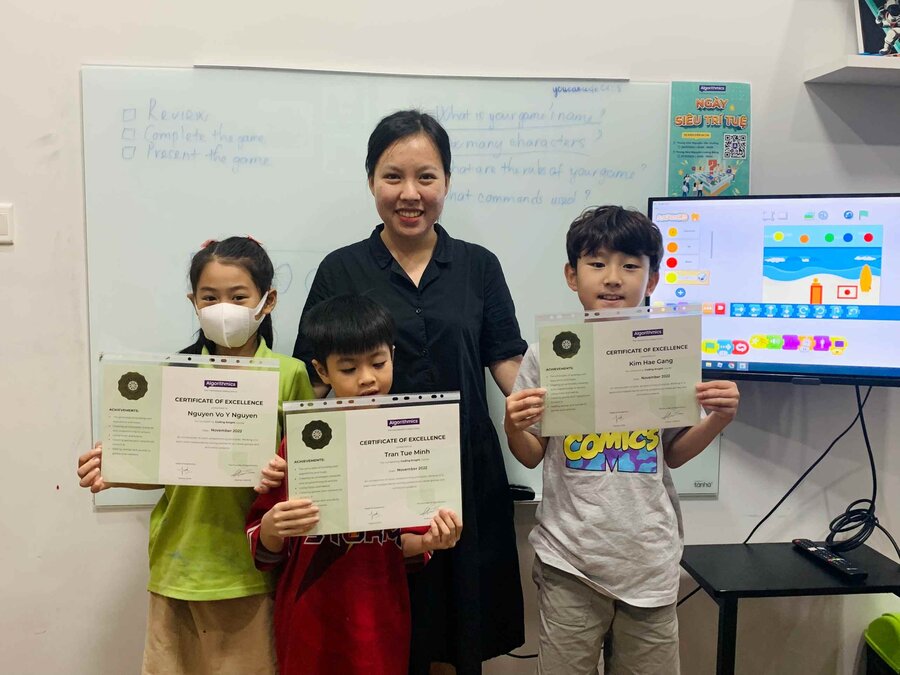
Communicate with children more: Parents can share about how the past, present and future are changing, why technology are important in the future, and children gradually learn more by using technology, coding language
Guide children to participate in courses: When at home, parents should help children familiarize and practice coding courses. Learning with the accompaniment of parents will help children pay attention and quickly grasp the transmitted knowledge.
Encourage children to learn on their own: Children will have more difficulty than adults when exposed to new goals and games. Parents and teachers can help children to explore at their own pace, but need to emphasis on developing self-discovery skills.
Choose an international, quality coding learning environment for children’s future development:
In Vietnam, education in technology is being emphasized with a wide range of options. For the best preparation, children should learn in an English – language environment with a digital learning platform based on each student’s own pace.
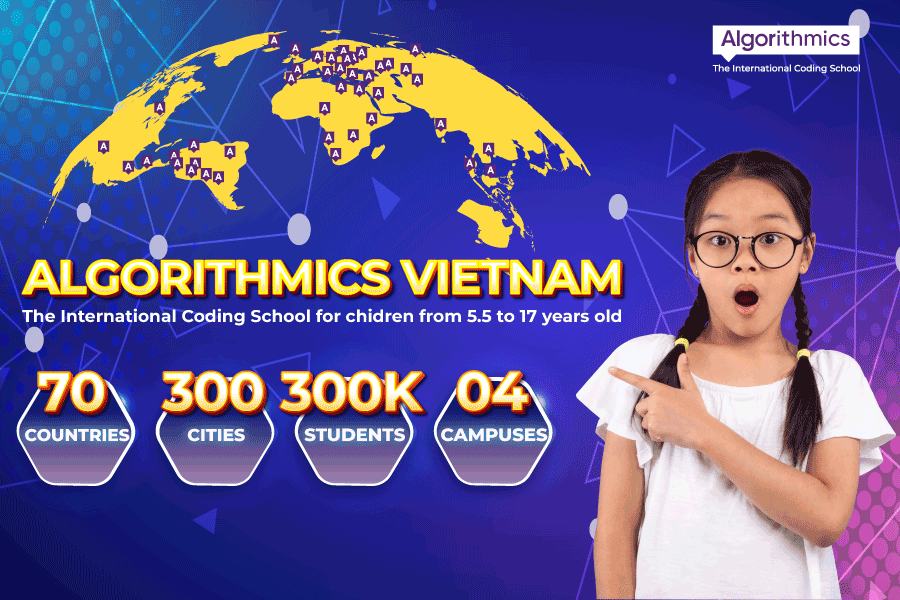
From September 11, 2021 to September 20, 2021, Algorithmics has a promotion to welcome the new school year. We give a students with free 4 weeks of learning design courses – G-Develop when registering any 8 months for a course currently teaching at our school. Algorithmics wants children to be fully developed in both coding and design skills, ready and confident to step into the future.